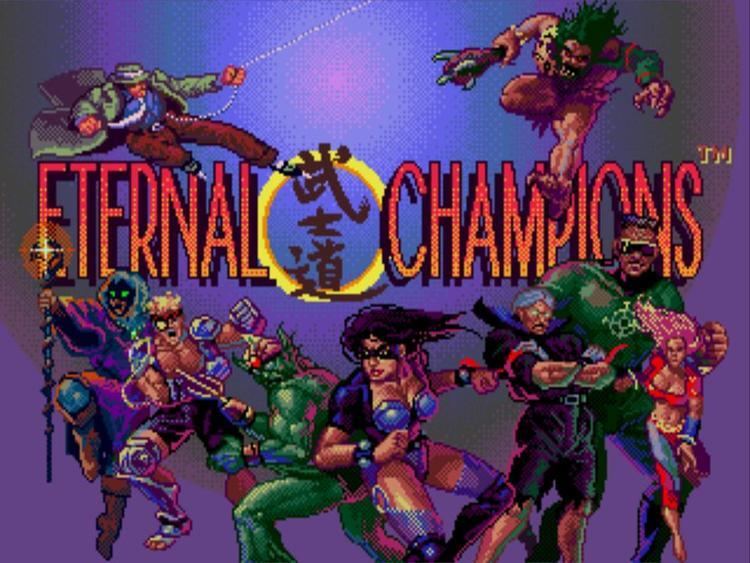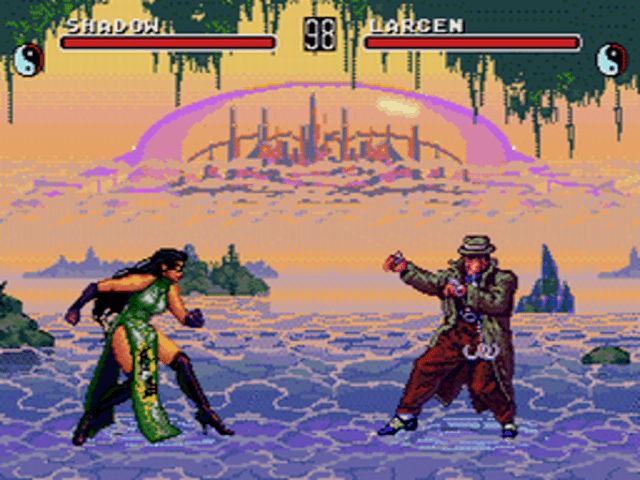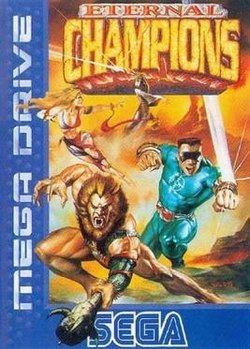9 /10 1 Votes9
4.7/5 CoolROM Director(s) Christopher Warner Designer(s) Michael Latham Artist(s) Albert Co Developers Sega, Interactive Designs | 8/10 Steam 4.9/5 Emuparadise Producer(s) Mark Nausha Programmer(s) John Kuwaye Initial release date 1993 | |||||||||||||||||||||||||||||||||
 | ||||||||||||||||||||||||||||||||||
Composer(s) Joe DeliaJohn HartJeff MarshAdrian van VelssenAndy Armer Modes Single-player video game, Multiplayer video game Similar Eternal Champions: Challeng, Alex Kidd in the Enchante, Kid Chameleon, ESWAT: City under Siege, Golden Axe II | ||||||||||||||||||||||||||||||||||
Classic game room eternal champions review for sega genesis
Eternal Champions is a fighting game developed and published by Sega for the Sega Genesis. It was one of the only fighting games of its time developed from the ground up as a home console title, rather than being released in arcades first and later ported to home systems, as was the standard during that era.
Contents
- Classic game room eternal champions review for sega genesis
- Gameplay
- Plot
- Release
- Promotion and other media
- Eternal Champions Special Moves Edition
- Reception
- Legacy
- Sequels
- Spin offs
- References

Sega released Eternal Champions for their Mega Drive/Genesis in 1993, hoping to capitalize on the fighting game mania that the game industry was in the midst of following the massive success of Street Fighter II (1991) and Mortal Kombat (1992). The game tried to set itself apart with unique features such as an heavier emphasis on its story, characters pulled from different time periods, reflectable projectiles, force fields, fighters that carried weapons, a training mode where players had to defend themselves against robotic traps, a novel method of executing moves, and elaborate stage-specific finishing moves called "Overkills".

Two years later, the sequel Eternal Champions: Challenge from the Dark Side (sometimes known as Eternal Champions CD or Eternal Champions 2) was released for the Mega-CD/Sega CD. There were also two spin-offs, action/adventure games set in the Eternal Champions universe and featuring some of its characters. Eternal Champions was added to the Wii's Virtual Console download service on December 3, 2007.

Gameplay

The game followed the typical eight-way directional pad/stick with six-button layout common to most fighting games at the time (more commonly in this case, Street Fighter II), forcing users of the standard three-button Mega Drive/Genesis controller to purchase a more elaborate, six-button controller or else use an inconvenient method of switching between punches and kicks by pressing start, as this game was especially developed to be played with the Sega Activator. The joystick or D-pad is used to move away, towards, jump and crouch. There were three punches and three kicks that vary based upon speed and power. The weakest punches and kicks are fast but do minimal damage, medium attacks are a good mix of recovery speed and damage, and strong attacks are the most powerful but recover the slowest. Attacks can be blocked by pressing away (for high attacks) or down and away (for low attacks). Grapples are executed by standing close to an opponent and pressing toward or away and either medium or the strong punch button. These attacks cannot be blocked or escaped.
Each character has their own unique special attacks that are performed differently from those of other characters. If a character is hit several times in a row they become "dizzy" and their opponent can land a free attack. In Eternal Champions, all special move commands are performed by either pressing multiple buttons together, or holding back or down to charge and then pressing towards or up together with a button. There are no rolling motions in this game, and a given special move may only be performed with a specific button.
As seen in Art of Fighting released the previous year, Eternal Champions has a "special attack meter" that decreases each time a character performed a special move such as a projectile; different special attacks decreased the meter by different amounts and the characters each have a taunt move that decreases their opponent's special attack meter as well. This feature gave Eternal Champions an added element of strategy that made it unique among similar titles of its genre at the time, though it was not without its critics: while its intention was to keep the action fast-paced by preventing fighters from trading endless projectiles from opposite ends of the screen and barring players from cheap wins due to repeated hits on opponents trapped at the edge of the screen, players found they could exploit the game's controls to achieve wins by retreating into a defensive shell to constantly recharge their meter or by circumventing special moves altogether and blitzing their opponent with a flurry of simple button presses. Characters that had more dynamic normal attacks tended to dominate. A problem with the special attack meter on the Sega Mega Drive original game is that when in tournament mode (the main single player arcade mode), the computer opponent operates independently of its special attack power availability. In other words, the computer can repeatedly do special moves even after its meter has reached zero.
The game introduces stage-specific finishing moves called Overkills. These are performed by defeating an opponent such that they fall upon a certain area of ground. If they land in the right spot, the life bars disappear and some element of the background kills them. The Overkills include being pulled underwater and mauled to death by carnivorous plants in Trident's stage, knocked into the flaming stake in Xavier's stage, electrocuted and vaporized by the neon sign in Shadow's stage, eaten whole and then having an item of clothing or weapon spat out by a Tyrannosaurus in Slash's stage, killed in a drive-by shooting in Larcen's stage, getting frozen and disintegrated before being swept up by robots in R.A.X's stage, being swallowed up by an earthquake in Jetta's stage, having a napalm bomb dropped on the loser's body in Midknight's stage, and getting knocked into a large exhaust fan in Blade's stage.
Plot
An omniscient being known as the Eternal Champion predicts that mankind will soon fade from existence due to the untimely and unjust deaths of key individuals throughout history who were destined for greatness. Seeking to restore balance to the world, the Eternal Champion gathers these souls from time moments before their deaths to participate in a fighting tournament. The victor will be able to change their fate and bring balance to the universe, whilst the losers will be forced to live out their deaths just as history intended.
Unlike most fighting games, or video games in general, there are no characters in this game that are "bad" or "evil". Each character has been chosen because they are either inherently good, or they have the potential to do great good and change the course of history for the better. Despite the ability to kill opponents in this game, this is not relevant to the story. Much like games such as Mortal Kombat (which pioneered finishing moves in fighting games), the game's "Overkills" are not canon and are simply a game play element for the enjoyment of the player. It is actually revealed in a few character endings that some of the fighters had become allies or friends during the course of the tournament.
Release
The cartridge also was the second "packaged game" to be included with the Sega Activator, an elaborate infrared ring controller that players stood in and punched and kicked in order to make the characters perform different combat movements. It was one of only a few games that actually recognized the Activator and took advantage of most of the features of the unit. The player using the Activator was given an advantage of receiving 50% less and inflicting 50% more damage than the player using a regular controller.
Promotion and other media
A Slurpee flavor entitled "Sega Eternal Champions Cherry" was once available in 7-Eleven stores throughout the United States. It came in cups with pictures of the characters on them, and the bottom of the cup contained a temporary tattoo. There was also a special cash & rebate promotion in July 1993 that was featured on MTV. Electronic Gaming Monthly sponsored Eternal Champions tournaments in the United States as part of a roaming video game show. The game, however, was not yet completed so the participants were only given the choice of four characters to play as: Shadow, R.A.X, Larcen and Slash.
Two gamebooks, titled Eternal Champions Adventure Gamebook: The Cyber Warriors and Eternal Champions Adventure Gamebook 2: Citadel of Chaos, were released by Puffin Books. In the books, the reader controls the newest Champion and travels through time helping the game characters battle a megalomaniacal artificial intelligence called the Overlord, who is bent on replacing them with duplicates so that they cannot change the course of history for the better. Both books were released as sticker albums by Panini in 1993.
Eternal Champions was adapted by the UK Sega Magazine's Sonic the Comic in a stand-alone magazine Eternal Champions Special, which introduced the main characters and served as an adaptation to the game. The characters also appeared in two stories in the main Sonic the Comic series, first in Eternal Champions (issues 19-24) and then Larcen's Revenge (issues 37-40) which dealt with the professional thief Larcen Tyler returning to 1920s Chicago and working with the female ninja Shadow Yamoto to take down the crime boss who killed him. Eternal Champions was the only non-Sonic-related Sega property to receive a special issue of Sonic the Comic.
Eternal Champions: Special Moves Edition
A handheld game by Tiger and a part of the Sega Tiger Electronic Pocket Arcade game series, it is basically a small and simple remake of Eternal Champions. It includes all nine characters and the Eternal Champion as a playable character. This version has three different types of game play, one-on-one, one against three, and team battle.
Reception
Upon the game's release, Eternal Champions was given a polarizing mixed reception, and currently holds an average aggregate score of 62.5% at GameRankings. Mean Machines Sega gave it a score of 97%, calling it "at least as good" as Street Fighter II, and Electronic Games gave it a 91%. The four reviewers of Electronic Gaming Monthly were divided, with two of them recommending the game based on the large number of options and the selection of moves, while the other two described it as a major disappointment, citing mediocre graphics and unexciting characters. They gave the game a 6.25 out of 10 average, with individual reviewer scores ranging from 5 to 8.
In 2008, IGN gave the Virtual Console release a score of 6 out of 10, criticizing its difficult to learn play mechanics while praising the game's story, training mode, and "inner strength meter". IGN concluded "it's not likely that many players who've never previously heard of the game will have the patience to spend that much time getting to know it."
In 2006, IGN ranked the game's finishing moves ("Overkills") as the best gore effects in video game history. In 2011, Complex included it on the list of ten "most blatant Mortal Kombat ripoffs" but added that it was "one of the more successful faux-MK fighters" and "the only thing that sucked was the difficulty." Complex also featured it on the 2012 list of the 25 Sega franchises they would like to see revisited and ranked it as the 24th best 2D fighting game of all time in 2013.
Legacy
Though Eternal Champions saw strong sales and was at one point a popular enough property to warrant a sequel, a remake, two spin-offs, and various multimedia tie-ins, after the planned third game in the core fighting series was cancelled Sega has not produced any new product for the franchise. The entire series had been absent from the compilations of Sega Genesis games that have been released on various platforms over the years, until the first entry saw release through Steam on September 13th, 2010.
Sequels
Eternal Champions: Challenge From the Dark Side kept the special attack meter but made most special attacks use less of the meter than in the previous game. Therefore, the characters gained a multitude of special attacks that did not deplete the special attack meter. Three new types of finishing moves were added in Challenge from the Dark Side: a second Overkill in each stage called Sudden Death (that could be activated when the victim still had a little life left), Vendetta, and Cinekill. Combo attacks were also introduced and jumping attacks could be linked to ground attacks and most normal attacks could be linked into other normal attacks. In addition, the game was significantly more violent and bloody than its predecessor, especially in the new finishing moves.
A third and a final title Eternal Champions: The Final Chapter was advertised for the Sega Saturn, but the game was cancelled shortly after beginning production, in order to push the Virtua Fighter series in the United States. According to an interview with Michael Latham, this decision was made by Sega of Japan: "Sega of Japan felt that Eternal Champions was keeping Virtua Fighter from being more successful in the US and that it would be better if the company focused on only one franchise.. ..and as Sega is a Japanese company, the Japan side won. It was a crushing blow, and was the only time in working nearly a decade at Sega I considered quitting. I mainly stayed with the hope to change that decision, but sadly never could. Even when we did the NetFighter project for Heat.net, we weren't able to use the Eternal characters as a hidden bonus. From Japan's view the game never existed, in spite of its stellar sales and even offers to do comic books and a cartoon around it."
Spin-offs
There are two video games which are spin-offs of the main Eternal Champions series, and are considered as being part of alternate universes to the main story of the core games, starring several popular Eternal Champions characters. The first game is Chicago Syndicate, an action game released for the Sega Game Gear portable platform in 1995. The plot is based in an alternate reality where Larcen Tyler did not die in 1920 as stated in Eternal Champions, and now seeks revenge on the Chicago Mafia. The second game, X-Perts, is a side-scrolling beat'em up released in 1996 for the Sega Mega Drive/Genesis. Like Chicago Syndicate, its plot is based in an alternate reality, this time one where Shadow Yamoto did not die in 1993 and instead formed a vigilante group.
